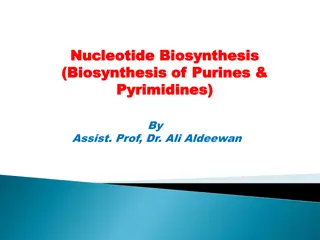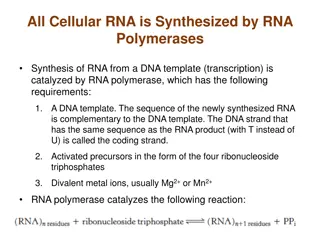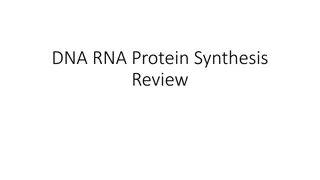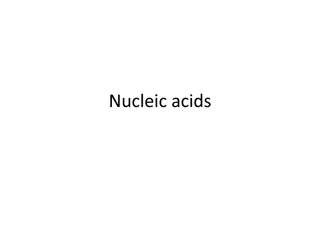Understanding Nucleic Acids: DNA, RNA, and Nucleotides
Nucleic acids are essential molecules that store genetic information and aid in protein production. This content delves into the monomeric structure of nucleotides, the differences between DNA and RNA, the unique characteristics of DNA's double helix structure versus RNA's single-stranded form, and the key role of nucleic acids in encoding instructions for protein synthesis. Additionally, it covers the nitrogenous bases present in nucleotides and the significance of the sugar-phosphate backbone in DNA and RNA.
Download Presentation

Please find below an Image/Link to download the presentation.
The content on the website is provided AS IS for your information and personal use only. It may not be sold, licensed, or shared on other websites without obtaining consent from the author. Download presentation by click this link. If you encounter any issues during the download, it is possible that the publisher has removed the file from their server.
E N D
Presentation Transcript
Unit 3 AoS1- Nucleic Acids To understand how nucleic acids are monomers of nucleotides that store genetic information and help produce proteins. I can: - define a nucleotide and nucleic acid. - explain the difference between DNA and RNA - describe the structure of DNA and RNA - nucleic acids as information molecules that encode instructions for the synthesis of proteins: the structure of DNA, the three main forms of RNA (mRNA, rRNA and tRNA) and a comparison of their respective nucleotides
Monomers & Polymers Monomers Smaller subunits of a polymer. The building blocks of cells E.g. Sugars, amino acids and nucleotides Polymers Large molecules made up of identical or similar units. Polymers are made when monomers are joined E.g. Starch, proteins and DNA/RNA
Nucleotide Nucleic Acid DNA- code for production of RNA RNA- can carry copy of DNA (mRNA) or translate DNA (tRNA). Major role in protein synthesis. a phosphate group a five-carbon (pentose) sugar Join together with strong phosphodiester bonds, creates the sugar-phosphate backbone a nitrogen-containing base.
Counting Carbon Each Carbon has a number - 1 attaches to the nitrogenous base - 3 attaches to the phosphate of the following nucleotide - 5 attaches the 5-carbon sugar to the phosphate group of the nucleotide * Important for recognising direction of DNA and RNA
Nitrogenous Base 5 Bases - - - - - Adenine (A) Guanine (G) Cytosine (C) Thymine (T) - in DNA only Uracil (In RNA only)
DNA (Deoxyribonucleic acid) 2 strands (double helix) 2 strands are antiparallel (run in opposite directions, with 3 end matching with 5 end of the other strand. Complementary base pairing occurs between nitrogenous bases (A & T, two weak hydrogen bonds) and (G & C, three weak hydrogen bonds)
Label as many things as you can :)
RNA (Ribonucleic acid) - The sugar is ribose instead of deoxyribose Single stranded Uracil replaces Thymine (still pairs with Adenine) - -
Three types 1. Messenger RNA (mRNA): carries genetic message to ribosomes for protein synthesis 2. Ribosomal RNA (rRNA): makes up ribosomes 3. Transfer RNA (tRNA): carries amino acids to ribosomes to make proteins (polypeptide chains).
ACTIVITY Edrolo 2B Question 9-15























